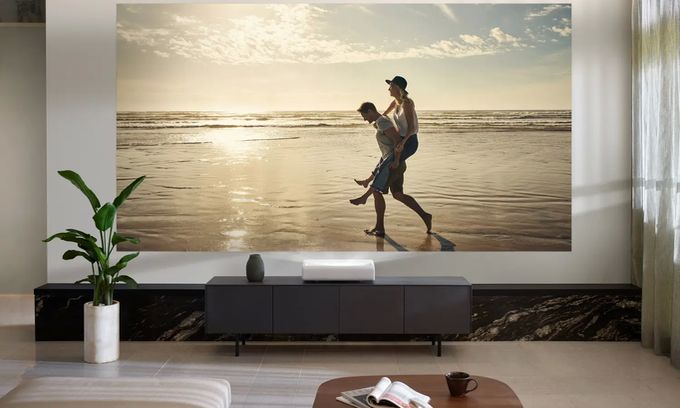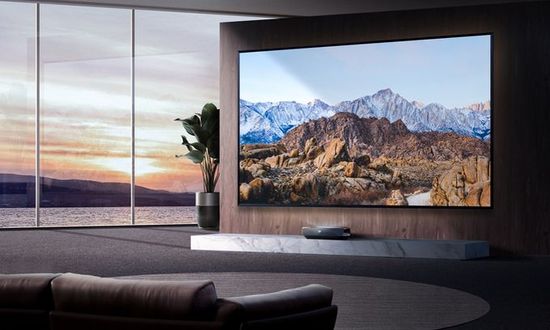For more than 10 years, the projector segment has been one of the most dynamically developing. Increasingly, they are replacing traditional TVs in living rooms, offering ever-improving picture quality on a huge screen at an affordable price. However, this trend is due to completely objective factors.
Projectors vs TVs
1. Light engines.
Unlike lamps, LEDs and laser LEDs (LEDs with an optical cavity that provides more powerful coherent radiation) do not heat up, do not require a powerful, noisy fan for cooling and a large internal volume for heat dissipation. Accordingly, they are compact and silent. Today laser models use ALPD-based (Advanced Laser Phosphor Display technology) light engines, including ALPD 3.0 (laser+phosphor), ALPD 4.0 (triple laser RGB light generator) and even hybrid ALPD 5.0 (3 LEDs + 3 lasers).
2. UST design (ultra short throw).
A mid-focus projector produces an image from a distance of several meters and is placed in the center of the room, creating the problem of wires on the floor. UST models provide image sizes of 100″ or larger from a very short distance. As a result, they are placed near the screen without this problem.
3. XPR (Xpanded Pixel Resolution) technology.
DMD (Digital Micromirror Device) chipsets from Texas Instrument with XPR support reduced the price of DLP 4K projectors. In fact, a projector with a relatively cheap 1080p chipset (2 million micromirrors) divides 8 million pixels of 4K content into four parts of 2 million pixels each. It then sequentially plays 4 separate 1080p frames diagonally shifted by half a pixel from each other. Our vision perceives them as one clearer picture, ignoring the micro-delay due to high frequency. For pixel shift, the projector uses the lens tilt with 4 electromagnets of the XPR module.
4. Finally, streaming and screen mirroring technologies have solved the problem of content for projector.
Of course, companies adequately respond to consumer rush, quickly filling the projector market with a huge assortment. Annually at the January CES (Consumer Electronics Show) in Las Vegas, they announce the range expansion, and 2024 was no exception.
Hisense
Just like a year ago, the company announced an 8K UST laser projector. Unfortunately, last year’s announcement never came to fruition. The company promises a new model by mid-2025. Presumably, it will use a new-generation .94″ DLP chip with a native 4K array and four-phase pixel-shift.
Its audio screen can become its key feature. The integrated audio transducers turn the its entire surface into a speaker system. The audio detail is not yet ideal at mid and high frequency range, but the company has enough time to improve it.
Hisense also introduced a rollable fresnel screen in a floor-rising canister.
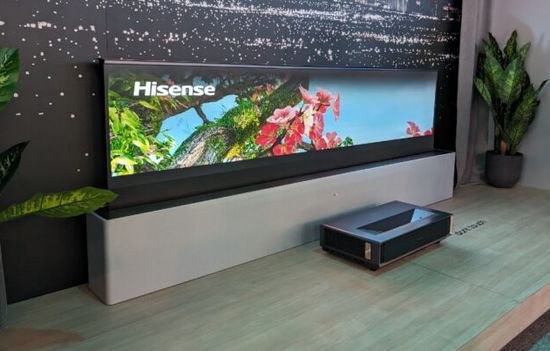
But prototype of Dynamic Light Steering UST Laser TV (Barco Bright technology) claims to become a sensation.
As known, OLED panels or LCD TVs with local dimming adjust the brightness of each pixel or group of pixels, providing dimming or brighter highlights in different zones. As a result, they provide superb contrast.
Of course, the overall light output of the laser engine in projector is also adjustable, but it’s the same for all pixels. Accordingly, it’s impossible to simultaneously increase the brightness in light areas and increase the depth of black.
Of course, professional projector manufacturers are solving this problem. For example, Christie Eclipse uses dual-modulation six-chip system. In this circuit, three chips control light output from the lasers, performing the function of local dimming.
Barco monitors content of each frame and redistributes the light flux to brighter areas using analogue of phase modulation. According to the developer, this technology provides up to a 50% deepening of blacks, and a 500% increase in peak brightness for highlights.
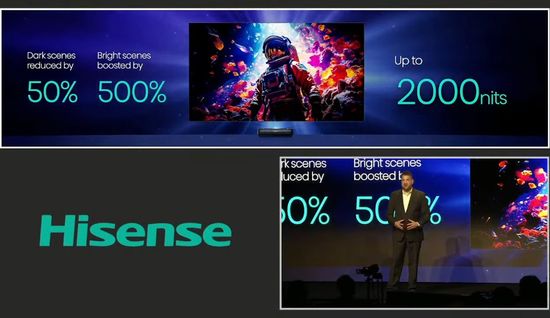
Of course, a significant increase in contrast promises to radically improve the HDR performance of projectors.
Formovie
As known, Formovie is a joint venture between Xiaomi and Appotronics. Chinese giant Xiaomi needs no introduction. Appotronics develops and makes the ALPD laser engines. Formovie Technology also offers budget-priced models under Xming brand.
Judging by the specs, the flagship Formovie 4K Max (Fengmi MAX 4K in China) claims a place in many of this year’s top lists. Its price in the US reaches ~ $ 3,700 via their importer ProjectorScreen.com. Unfortunately, the model uses FengOS and comes with streaming platform for Chinese market. But, ProjectorScreen ships the projector with an Amazon Firestick 4K dongle.
In fact, 4K Max could launch a new line of very bright Formovie UST projectors. Indeed, Formovie Theater and its budget C3 version provide the best image quality with wide color gamut of triple laser light engine. They are ideal for watching movies on a huge screen in the evening, but are unlikely to be optimal in a bright living room due to limited brightness. The Formovie 4K Max with ALPD 3.0-based light engine offers unprecedented brightness of up to 4,500 ANSI Lumens, delivering rich colors even in diffuse daylight without additional dimming.
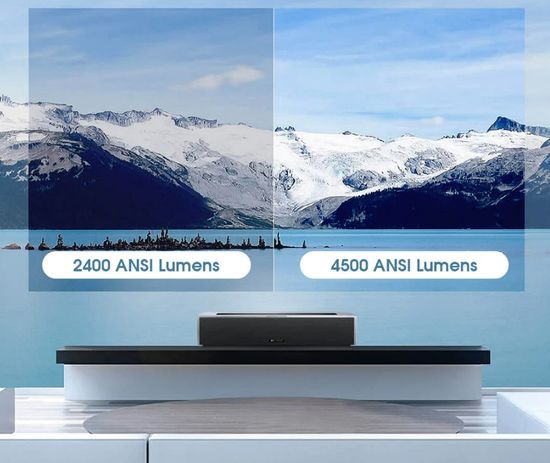
Its screen size varies in the range of 80″- 200″ at 0.25:1 throw ratio, which is a record for this segment.
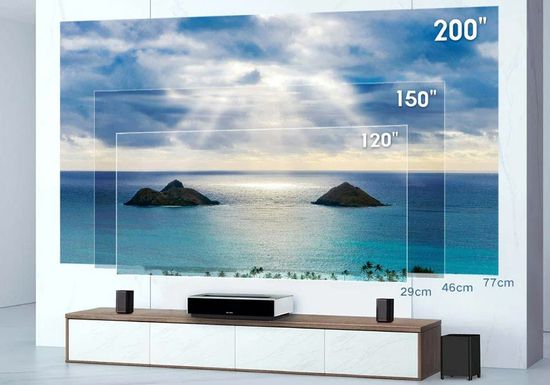
But to be fair, increasing the size reduces colors saturation and image clarity. In addition, today the size of the largest UST Spectra Projection Vantage Screen is only 150″.
Model uses a .47 DLP chipset from Texas Instruments with XPR technology, providing 4K resolution through 4-phase pixel shift.
Specs
– 100% Rec.709 color gamut;
– native 3,000:1 contrast ratio;
– MEMC;
– HDR10+ and HLG;
– 2x 20W speakers;
– Bluetooth 4.1 and dual band WiFi.
LG and Samsung projectors
LG introduced ultra compact triple-laser 4K CineBeam Qube (HU710PB) projector.
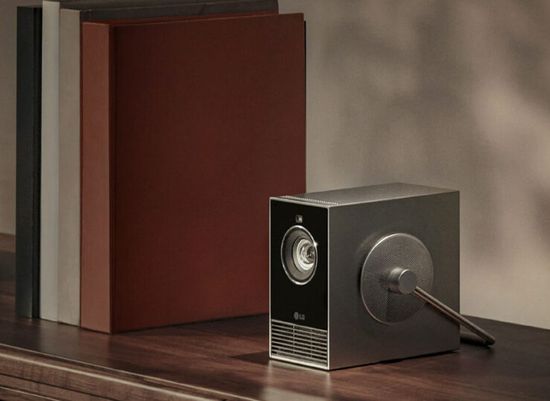
With a size and weight of 5.31″ x 5.31″ x 3.15″ and 3.3lbs, it can easily compete with the smallest triple-laser Optoma ML1080 (6.18″ x 5.31″ x 2.68″ and 2.3lbs, 1080p resolution).
Specs
– 500 ANSI Lumens brightness with triple laser RGB light engine;
– UHD (3,840 x 2,160) resolution;
– 450,000:1 dynamic contrast ratio;
– HDR10 and HLG;
– 154% DCI-P3 color gamut;
– 50-120 inches screen sizes;
– ASA (Auto Screen Adjustment – auto-focus and placement);
– webOS 6.0;
– auto keystone adjustment.
Samsung presented a new version of Premiere 8K announced last year. According to the company, it’s the first wireless UST 8K projector with Wi-Fi-based Samsung’s One Connect technology. It supports wireless connection for up to 8K signal within a maximum distance of 10m (~33ft) from the connection hub.
The triple-laser RGB light engine provides up to 4,000 lumens. The screen size reaches 150″ diagonally.
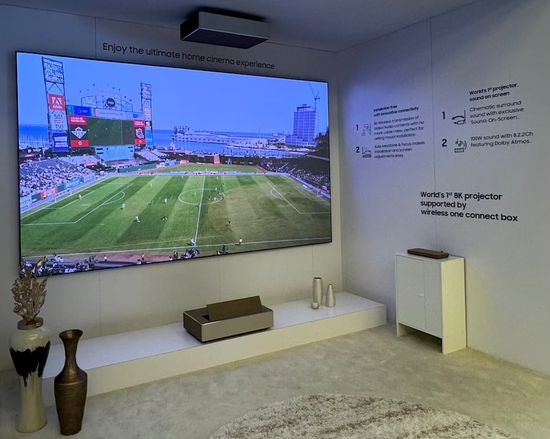
The 100W 8.2.2ch Dolby Atmos sound system with Sound-on-Screen technology creates cinematic surround audio.
Additionally, Samsung’s projectors 2024 offer innovative Lightwarp feature, which turns the projection into an interactive display.
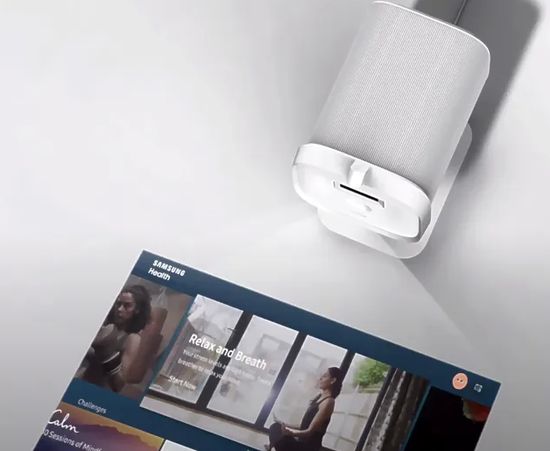
It operation principle is similar to sensor-equipped interactive devices for classroom whiteboard.
The ultra compact Premiere 5 became the smallest ultra-short throw projector with triple-laser RGB light engine (5.5″ square x 8″ tall). It’s slightly larger vs mid-focal Optoma ML1080/ML1080ST and LG Qube. Model creates 100″@17″, has auto-keystone/focus/color balance adjustments, Bluetooth, 10W speaker system and supports Samsung Gaming Hub.
In addition, the company promises single-laser Premiere 7 and triple-laser Premiere 9 UST models, which replace last year’s LSP7T and LSP9T. New versions are brighter and use Quantum 4K video processor.
Conclusion
Competition between TVs and UST projectors continues to grow. On the one hand, TVs manufacturers have significantly expanded the range of huge models. This year their list has expanded with:
– 115in TCL QM891G and 98in TCL QM851G;
– 110in / 98in Hisense UX and 100in U76N models;
– 98in Samsung QN900D 8K and QN90D Neo 4K TVs;
– wireless 97in LG OLED M and flagship OLED G4.
To be fair, they are brighter and more contrasting, but significantly more expensive. But their prices are falling significantly and today already range from $ 5,000 to $ 10,000.
In turn, projector developers have presented an impressive array of innovations, including:
– hybrid ALPD 5.0-based light engine (RGB Laser + RGB LED) with ultra wide color gamut and unprecedented DeltaE < 1 color accuracy in NexiGo TriVision Ultra and Dangbei X5 Ultra;
– hybrid Dual Light 2.0-based XGIMI Horizon Max (triple-laser RGB source + phosphor wheel, no laser specks);
– Samsung’s Lightwarp feature (interactive function);
– Hisense projector with Barco Bright technology-based Light Steering (superb HDR performance with 50% for blacks and 500% increase in peak brightness);
– Hisense Sonic Screen 8K;
– NexiGo TriVision Ultra with hybrid ALPD 5.0 light engine.
– Google TV streaming platform with access to Netflix without a separate dongle.
When factoring in prices and size, the difference of price/quality ratio between huge TVs and projectors continues to decrease. In general, the projector wins during viewing without ambient light, but loses when viewing with diffused daylight.
This video shows an extravagant concept of a Xiaomi XGIMI Magic Lamp projector integrated with a ceiling lamp.
